Implementation of a Collaborative Recommendation System Based on Multi-Clustering
Abstract
1. Introduction
- The proposed algorithm calculates similarity based on user ratings; the system recommends the most correlated movie list.
- Recommending appropriate movies based on a user’s characteristics; determine the item type (genre) based on behavioral information.
- Using item information and user interaction data, we designed a double-end attention mechanism to determine the user’s preferences and social relationships. In this way, we can identify users’ preferences, distinguish the importance of user relationships, and identify neighbors who influence users’ preferences significantly.
2. Related Work
3. Overview of the Recommendation System
3.1. Datasets
3.2. Performance
- Collaborative filtering is necessary to collect and analyze data transactions regarding the user’s actions and backgrounds. Then, predictions are made about which users will become engaged by their similarities to other users.
- As a basis for our analysis, we considered the “IMDb 5000 movies” and “IMDb 5000 credits” datasets, which totaled 3,315,117 and included votes (0 to 10), resulting in a total of 4804 movies. The details contained budget, genres, movie ID, cast, crew, language, movie names, production, countries, release date, and revenue [19,53].
- In addition to parts of tags, a Naive Bayes classification method is used for a semantic approach [54]. We considered the point-wise mutual information difference between an item with a positive connotation and a term with a negative connotation.
- Coefficients contain similar cluster users for more accurate clusters [59].
4. Proposed Method
4.1. Problem Implementation
4.2. Computation
| Algorithm 1: Similarity |
 |
5. Experiments and Results
5.1. Cluster Analysis
| Algorithm 2: Expectation-maximization |
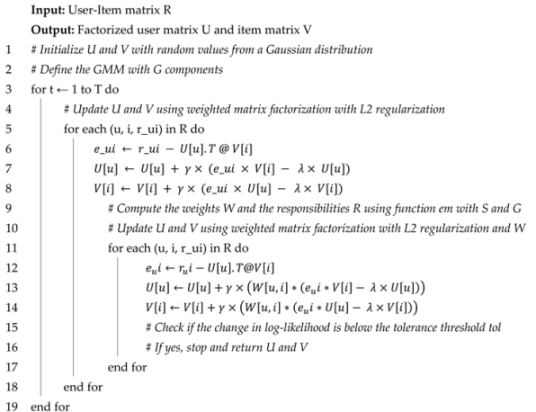 |
5.2. Performance Analysis
5.3. Evaluation of Results
6. Discussion
6.1. Final Recommendation
6.2. Evaluation of Proposed Method
6.3. Limitation
7. Conclusions and Future Work
Author Contributions
Funding
Data Availability Statement
Acknowledgments
Conflicts of Interest
References
- Adeniyi, D.A.; Wei, Z.; Yongquan, Y. Automated web usage data mining and recommendation system using K-Nearest Neighbor (KNN) classification method. Appl. Comput. Inform. 2016, 12, 90–108. [Google Scholar] [CrossRef]
- Afoudi, Y.; Lazaar, M.; Achhab, M. Hybrid recommendation system combined content-based filtering and collaborative prediction using artificial neural network. Simul. Model. Pract. Theory 2021, 113, 102375. [Google Scholar] [CrossRef]
- Ahsan, M.; Marton, F.; Pintus, R.; Gobbetti, E. Audio–visual annotation graphs for guiding lens-based scene exploration. Comput. Graph. 2022, 105, 131–145. [Google Scholar] [CrossRef]
- Bag, S.; Kumar, S.K.; Tiwari, M.K. An efficient recommendation generation using relevant Jaccard similarity. Inf. Sci. 2019, 483, 53–64. [Google Scholar] [CrossRef]
- Bai, Y.; Li, H. Mapping the evolution of e-commerce research through co-word analysis: 2001–2020. Electron. Commer. Res. Appl. 2022, 55, 101190. [Google Scholar] [CrossRef]
- Bakshi, S.; Jagadev, A.K.; Dehuri, S.; Wang, G.N. Enhancing scalability and accuracy of recommendation systems using unsupervised learning and particle swarm optimization. Appl. Soft Comput. 2014, 15, 21–29. [Google Scholar] [CrossRef]
- Bernhardt, P.W.; Zhang, D.; Wang, H.J. A fast EM algorithm for fitting joint models of a binary response and multiple longitudinal covariates subject to detection limits. Comput. Stat. Data Anal. 2015, 85, 37–53. [Google Scholar] [CrossRef]
- Wu, C.S.M.; Garg, D.; Bhandary, U. Movie recommendation system using collaborative filtering. In Proceedings of the 2018 IEEE 9th International Conference on Software Engineering and Service Science (ICSESS), Beijing, China, 23–25 November 2018. [Google Scholar] [CrossRef]
- Bromberek-Dyzman, K.; Jankowiak, K.; Chełminiak, P. Modality matters: Testing bilingual irony comprehension in the textual, auditory, and audio-visual modality. J. Pragmat. 2021, 180, 219–231. [Google Scholar] [CrossRef]
- Chen, Y.L.; Yeh, Y.H.; Ma, M.R. A movie recommendation method based on users’ positive and negative profiles. Inf. Process. Manag. 2021, 58, 102531. [Google Scholar] [CrossRef]
- Chou, Y.C.; Chen, C.T.; Huang, S.H. Modeling behavior sequence for personalized fund recommendation with graphical deep collaborative filtering. Expert Syst. Appl. 2022, 192, 116311. [Google Scholar] [CrossRef]
- Cui, Z.; Zhao, P.; Hu, Z.; Cai, X.; Zhang, W.; Chen, J. An improved matrix factorization based model for many-objective optimization recommendation. Inf. Sci. 2021, 579, 1–14. [Google Scholar] [CrossRef]
- da Silva, D.C.; Manzato, M.G.; Durão, F.A. Exploiting personalized calibration and metrics for fairness recommendation. Expert Syst. Appl. 2021, 181, 115112. [Google Scholar] [CrossRef]
- Da’u, A.; Salim, N.; Idris, R. Multi-level attentive deep user-item representation learning for recommendation system. Neurocomputing 2021, 433, 119–130. [Google Scholar]
- Dhawan, S.; Singh, K.; Rabaea, A.; Batra, A. ImprovedGCN: An efficient and accurate recommendation system employing lightweight graph convolutional networks in social media. Electron. Commer. Res. Appl. 2022, 55, 101191. [Google Scholar] [CrossRef]
- Feng, L.; Liu, W.; Meng, X.; Zhang, Y. Re-weighted multi-view clustering via triplex regularized non-negative matrix factorization. Neurocomputing 2021, 464, 352–363. [Google Scholar] [CrossRef]
- Fopa, M.; Gueye, M.; Ndiaye, S.; Naacke, H. A parameter-free KNN for rating prediction. Data Knowl. Eng. 2022, 142, 102095. [Google Scholar] [CrossRef]
- Huang, Z.; Ma, H.; Wang, S.; Shen, Y. Accurate Item Recommendation Algorithm of itemrank based on tag and context information. Comput. Commun. 2021, 176, 282–289. [Google Scholar] [CrossRef]
- IMDb. Available online: https://www.imdb.com/interfaces (accessed on 12 December 2022).
- Iwanaga, J.; Nishimura, N.; Sukegawa, N.; Takano, Y. Improving collaborative filtering recommendations by estimating user preferences from clickstream data. Electron. Commer. Res. Appl. 2019, 37, 100877. [Google Scholar] [CrossRef]
- Yager, R.R. Fuzzy logic methods in recommender systems. Fuzzy Sets Syst. 2003, 136, 133–149. [Google Scholar] [CrossRef]
- Karthik, R.V.; Ganapathy, S. A fuzzy recommendation system for predicting the customers interests using sentiment analysis and ontology in e-commerce. Appl. Soft Comput. 2021, 108, 107396. [Google Scholar] [CrossRef]
- Khojamli, H.; Razmara, J. Survey of similarity functions on neighborhood-based collaborative filtering. Expert Syst. Appl. 2021, 185, 115482. [Google Scholar] [CrossRef]
- Kim, H.N.; El Saddik, A. A stochastic approach to group recommendations in social media systems. Inf. Syst. 2015, 50, 76–93. [Google Scholar] [CrossRef]
- Park, D.H.; Kim, H.K.; Choi, I.Y.; Kim, J.K. A literature review and classification of recommender systems research. Expert Syst. Appl. 2012, 39, 10059–10072. [Google Scholar] [CrossRef]
- Lü, L.; Medo, M.; Yeung, C.H.; Zhang, Y.C.; Zhang, Z.K.; Zhou, T. Recommender systems. Phys. Rep. 2012, 519, 1–49. [Google Scholar] [CrossRef]
- Isinkaye, F.O.; Folajimi, Y.O.; Ojokoh, B.A. Recommendation systems: Principles, methods and evaluation. Egypt. Inform. J. 2015, 16, 261–273. [Google Scholar] [CrossRef]
- Huang, S.L. Designing utility-based recommender systems for e-commerce: Evaluation of preference-elicitation methods. Electron. Commer. Res. Appl. 2011, 10, 398–407. [Google Scholar] [CrossRef]
- Burke, R.D.; Abdollahpouri, H.; Mobasher, B.; Gupta, T. Towards multi-stakeholder utility evaluation of recommender systems. In Proceedings of the User Modeling, Adaptation and Personalization Conference, Halifax, NS, Canada, 13–17 July 2016; Volume 750. [Google Scholar]
- Prangl, M.; Szkaliczki, T.; Hellwagner, H. A framework for utility-based multimedia adaptation. IEEE Trans. Circuits Syst. Video Technol. 2007, 17, 719–728. [Google Scholar] [CrossRef]
- Lekakos, G.; Caravelas, P. A hybrid approach for movie recommendation. Multimed. Tools Appl. 2008, 36, 55–70. [Google Scholar] [CrossRef]
- Grant, S.; McCalla, G.I. A hybrid approach to making recommendations and its application to the movie domain. In Proceedings of the Advances in Artificial Intelligence: 14th Biennial Conference of the Canadian Society for Computational Studies of Intelligence, Ottawa, ON, Canada, 7–9 June 2001. [Google Scholar]
- Nguyen, N.T.; Rakowski, M.; Rusin, M.; Sobecki, J.; Jain, L.C. Hybrid filtering methods applied in web-based movie recommendation system. In Proceedings of the Knowledge-Based Intelligent Information and Engineering Systems: 11th International Conference, KES 2007, XVII Italian Workshop on Neural Networks, Vietri sul Mare, Italy, 2–14 September 2007. [Google Scholar]
- Carrer-Neto, W.; Hernández-Alcaraz, M.L.; Valencia-García, R.; García-Sánchez, F. Social knowledge-based recommender system. Application to the movies domain. Expert Syst. Appl. 2012, 39, 10990–11000. [Google Scholar] [CrossRef]
- Walek, B.; Fojtik, V. A hybrid recommender system for recommending relevant movies using an expert system. Expert Syst. Appl. 2020, 158, 113452. [Google Scholar] [CrossRef]
- Moreno, M.N.; Segrera, S.; López, V.F.; Muñoz, M.D.; Sánchez, Á.L. Web mining based framework for solving usual problems in recommender systems. A case study for movies’ recommendation. Neurocomputing 2016, 176, 72–80. [Google Scholar] [CrossRef]
- Koren, Y.; Bell, R.; Volinsky, C. Matrix factorization techniques for recommender systems. Computer 2009, 42, 30–37. [Google Scholar] [CrossRef]
- Krzywicki, A.; Wobcke, W.; Kim, Y.S.; Cai, X.; Bain, M.; Mahidadia, A.; Compton, P. Collaborative Filtering for people-to-people recommendation in online dating: Data analysis and user trial. Int. J. Hum.-Comput. Stud. 2009, 76, 50–66. [Google Scholar] [CrossRef]
- Liang, Y.; Wu, C.; Zhang, M.; Ji, X.; Shen, Y.; He, J.; Zhang, Z. Statistical modelling of the joint probability density function of air density and wind speed for wind resource assessment: A case study from China. Energy Convers. Manag. 2022, 268, 116054. [Google Scholar] [CrossRef]
- Lin, B.; Fang, B.; Yang, W.; Qian, J. Human action recognition based on spatio-temporal three-dimensional scattering transform descriptor and an improved VLAD feature encoding algorithm. Neurocomputing 2019, 348, 145–157. [Google Scholar] [CrossRef]
- Linke, A.C.; Mash, L.E.; Fong, C.H.; Kinnear, M.K.; Kohli, J.S.; Wilkinson, M.; Tung, R.; Jao Keehn, R.J.; Carper, R.A.; Fishman, I.; et al. Dynamic time warping outperforms Pearson correlation in detecting atypical functional connectivity in autism spectrum disorders. NeuroImage 2020, 223, 117383. [Google Scholar] [CrossRef]
- Liu, D.; Li, J.; Wu, J.; Du, B.; Chang, J.; Li, X. Interest Evolution-driven Gated Neighborhood aggregation representation for dynamic recommendation in e-commerce. Inf. Process. Manag. 2022, 59, 102982. [Google Scholar] [CrossRef]
- Michaela Denise Gonzales, R.; Hargreaves, C.A. How can we use artificial intelligence for stock recommendation and risk management? A proposed decision support system. Int. J. Inf. Manag. Data Insights 2022, 2, 100130. [Google Scholar] [CrossRef]
- Montero, D.; Aginako, N.; Sierra, B.; Nieto, M. Efficient large-scale face clustering using an online Mixture of Gaussians. Eng. Appl. Artif. Intell. 2022, 114, 105079. [Google Scholar] [CrossRef]
- Mu, C.; Chen, W.; Liu, Y.; Lei, D.; Liu, R. Virtual information core optimization for collaborative filtering recommendation based on clustering and evolutionary algorithms. Appl. Soft Comput. 2022, 116, 108355. [Google Scholar] [CrossRef]
- Nam, L.N.H. Towards comprehensive approaches for the rating prediction phase in memory-based collaborative filtering recommender systems. Inf. Sci. 2022, 589, 878–910. [Google Scholar] [CrossRef]
- Narwal, P.; Duhan, N.; Kumar Bhatia, K. A comprehensive survey and mathematical insights towards video summarization. J. Vis. Commun. Image Represent. 2022, 89, 103670. [Google Scholar] [CrossRef]
- Ni, X.; Lu, Y.; Quan, X.; Wenyin, L.; Hua, B. User interest modeling and its application for question recommendation in user-interactive question answering systems. Inf. Process. Manag. 2012, 48, 218–233. [Google Scholar] [CrossRef]
- Ortega, F.; Hernando, A.; Bobadilla, J.; Kang, J.H. Recommending items to group of users using Matrix Factorization based Collaborative Filtering. Inf. Sci. 2016, 345, 313–324. [Google Scholar] [CrossRef]
- Park, J.; Lee, Y.C.; Kim, S.W. Effective and efficient negative sampling in metric learning based recommendation. Inf. Sci. 2022, 605, 351–365. [Google Scholar] [CrossRef]
- Parveen, R.; Varma, N.S. Friend’s recommendation on social media using different algorithms of machine learning. Glob. Transit. Proc. 2021, 2, 273–281. [Google Scholar] [CrossRef]
- Rahman, A.; Hossen, M.S. Sentiment Analysis on Movie Review Data Using Machine Learning Approach. In Proceedings of the 2019 International Conference on Bangla Speech and Language Processing, Sylhet, Bangladesh, 27–28 September 2019. [Google Scholar]
- Rahmani, H.A.; Deldjoo, Y.; di Noia, T. The role of context fusion on accuracy, beyond-accuracy, and fairness of point-of-interest recommendation systems. Expert Syst. Appl. 2022, 205, 117700. [Google Scholar] [CrossRef]
- Singh, P.; Srivastava, R.; Rana, K.P.S.; Kumar, V. A multimodal hierarchical approach to speech emotion recognition from audio and text. Knowl.-Based Syst. 2021, 229, 107316. [Google Scholar] [CrossRef]
- Slater, S.; Baker, P.; Lawrence, M. An analysis of the transformative potential of major food system report recommendations. Glob. Food Secur. 2022, 32, 100610. [Google Scholar] [CrossRef]
- Soubraylu, S.; Rajalakshmi, R. Hybrid convolutional bidirectional recurrent neural network based sentiment analysis on movie reviews. Comput. Intell. 2021, 37, 735–757. [Google Scholar] [CrossRef]
- Sundari, P.S.; Subaji, M. An improved hidden behavioral pattern mining approach to enhance the performance of recommendation system in a big data environment. J. King Saud Univ. Comput. Inf. Sci. 2020, 34, 8390–8400. [Google Scholar] [CrossRef]
- Wang, K.; Zhang, T.; Xue, T.; Lu, Y.; Na, S.G. E-commerce personalized recommendation analysis by deeply-learned clustering. J. Vis. Commun. Image Represent. 2020, 71, 102735. [Google Scholar] [CrossRef]
- Chen, H. Personalized recommendation system of e-commerce based on big data analysis. J. Interdiscip. Math. 2018, 21, 1243–1247. [Google Scholar] [CrossRef]
- Wijaya, I.W.R. Mudjahidin Development of conceptual model to increase customer interest using recommendation system in e-commerce. Procedia Comput. Sci. 2021, 197, 727–733. [Google Scholar] [CrossRef]
- Wu, B.; Zhong, L.; Li, H.; Ye, Y. Efficient complementary graph convolutional network without negative sampling for item recommendation. Knowl.-Based Syst. 2022, 256, 109758. [Google Scholar] [CrossRef]
- Xu, H.; Yang, B.; Liu, X.; Fan, W.; Li, Q. Category-aware Multi-relation Heterogeneous Graph Neural Networks for session-based recommendation. Knowl.-Based Syst. 2022, 251, 109246. [Google Scholar] [CrossRef]
- Yasen, M.; Tedmori, S. Movies reviews sentiment analysis and classification. In Proceedings of the 2019 IEEE Jordan International Joint Conference on Electrical Engineering and Information Technology, JEEIT 2019 Proceedings, Amman, Jordan, 9–11 April 2019. [Google Scholar]
- Yin, J.; Sun, S. Incomplete multi-view clustering with cosine similarity. Pattern Recognit. 2022, 123, 108371. [Google Scholar] [CrossRef]
- Zamanzadeh Darban, Z.; Valipour, M.H. GHRS: Graph-based hybrid recommendation system with application to movie recommendation. Expert Syst. Appl. 2022, 200, 116850. [Google Scholar] [CrossRef]
- Zeng, J.; Hu, Z. Automated operational modal analysis using variational Gaussian mixture model. Eng. Struct. 2022, 273, 115139. [Google Scholar] [CrossRef]
- Zhang, C.; Duan, X.; Liu, F.; Li, X.; Liu, S. Three-way Naive Bayesian collaborative filtering recommendation model for smart city. Sustain. Cities Soc. 2022, 76, 103373. [Google Scholar] [CrossRef]
- Zhang, L.; Thalhammer, A.; Rettinger, A.; Färber, M.; Mogadala, A.; Denaux, R. The xLiMe system: Cross-lingual and cross-modal semantic annotation, search and recommendation over live-TV, news and social media streams. J. Web Semant. 2017, 46–47, 20–30. [Google Scholar] [CrossRef]
- Zhou, Q.; Zhuang, W.; Ren, H.; Chen, Y.; Yu, B.; Lou, J.; Wang, Y. Hybrid collaborative filtering model for consumer dynamic service recommendation based on mobile cloud information system. Inf. Process. Manag. 2022, 59, 102871. [Google Scholar] [CrossRef]
- Dong, X.; Yu, L.; Wu, Z.; Sun, Y.; Yuan, L.; Zhang, F. A hybrid collaborative filtering model with deep structure for recommender systems. In Proceedings of the AAAI Conference on Artificial Intelligence, San Francisco, CA, USA, 4–9 February 2017. [Google Scholar]
- Zhu, X.; Ying, C.; Wang, J.; Li, J.; Lai, X.; Wang, G. Ensemble of ML-KNN for classification algorithm recommendation. Knowl.-Based Syst. 2021, 221, 106933. [Google Scholar] [CrossRef]
- Zhu, Z.; Wang, S.; Wang, F.; Tu, Z. Recommendation networks of homogeneous products on an E-commerce platform: Measurement and competition effects. Expert Syst. Appl. 2022, 201, 117128. [Google Scholar] [CrossRef]
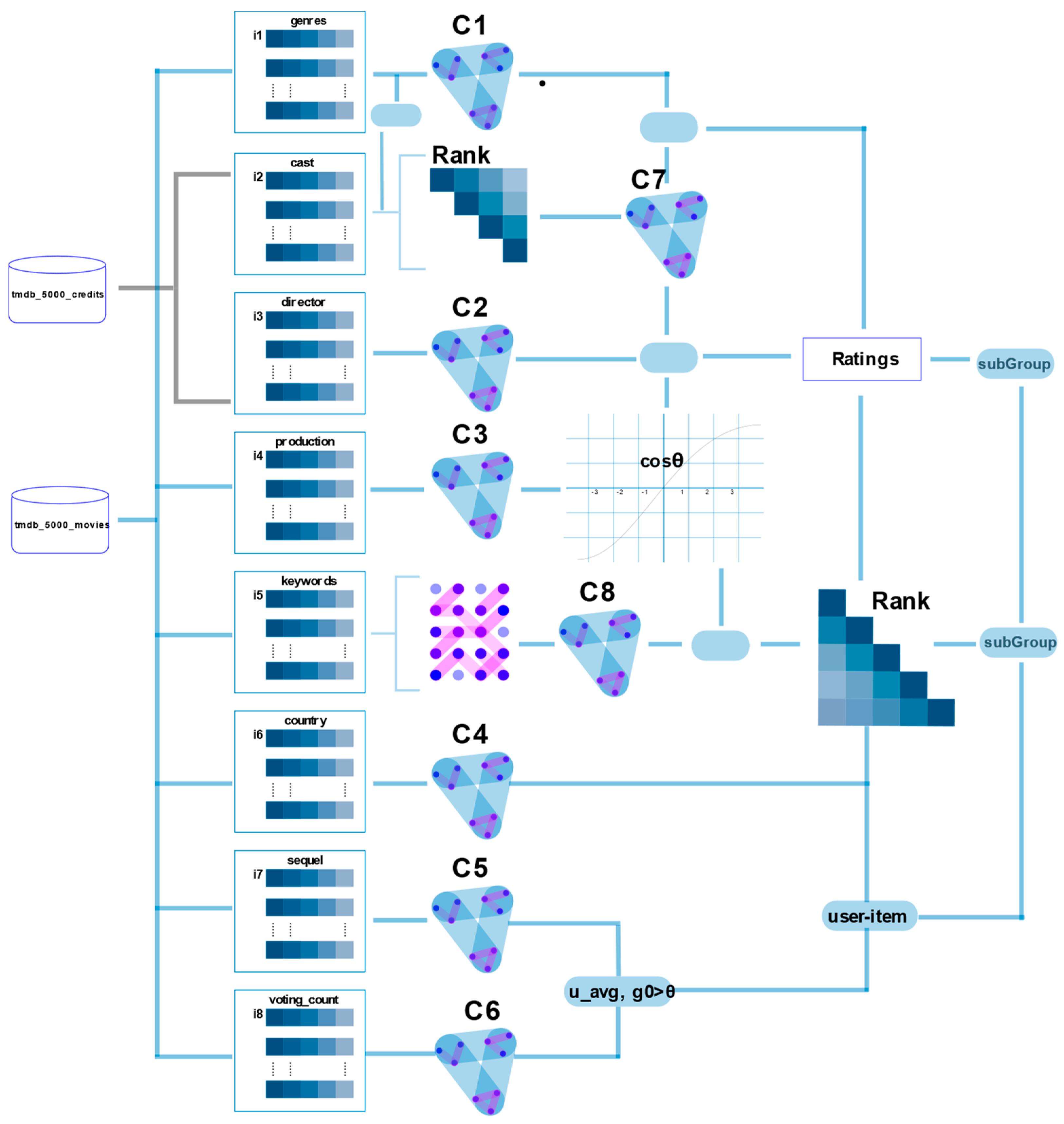

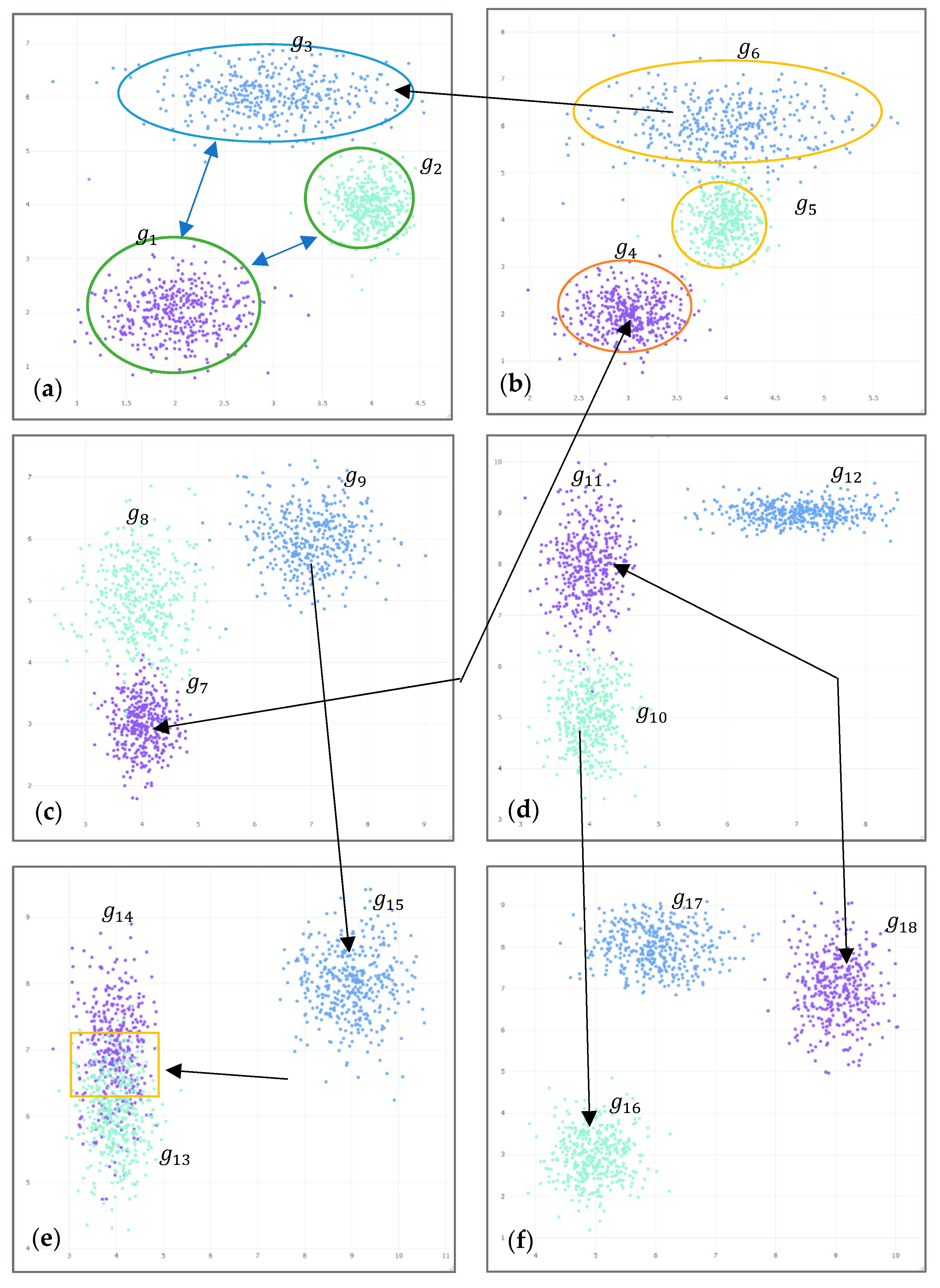
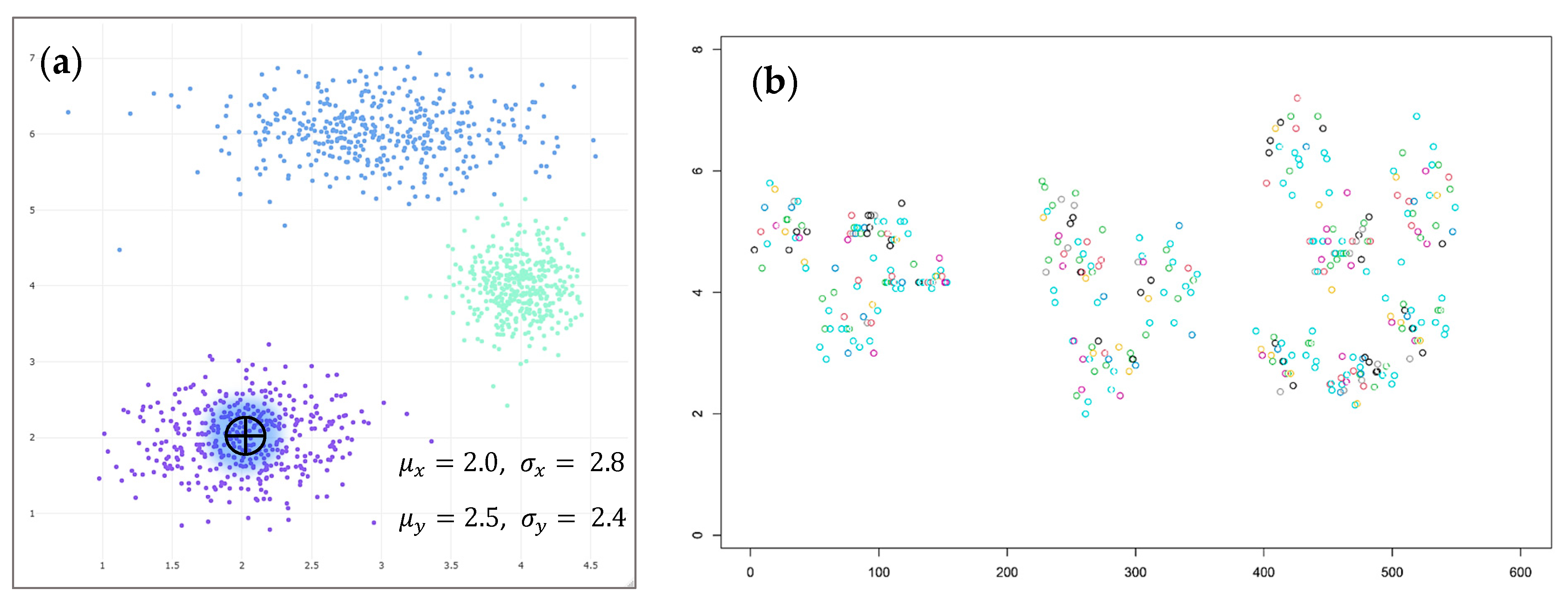

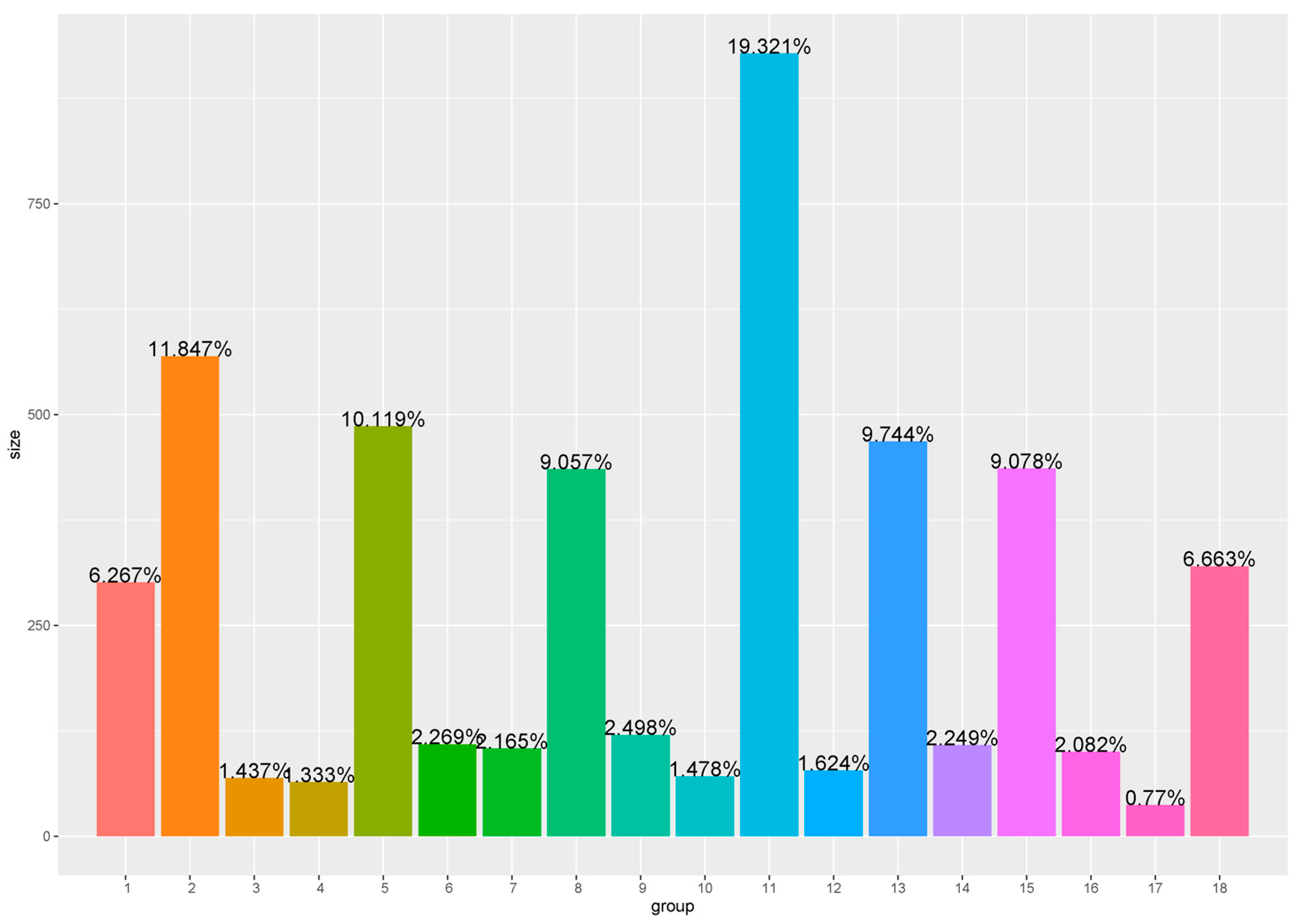
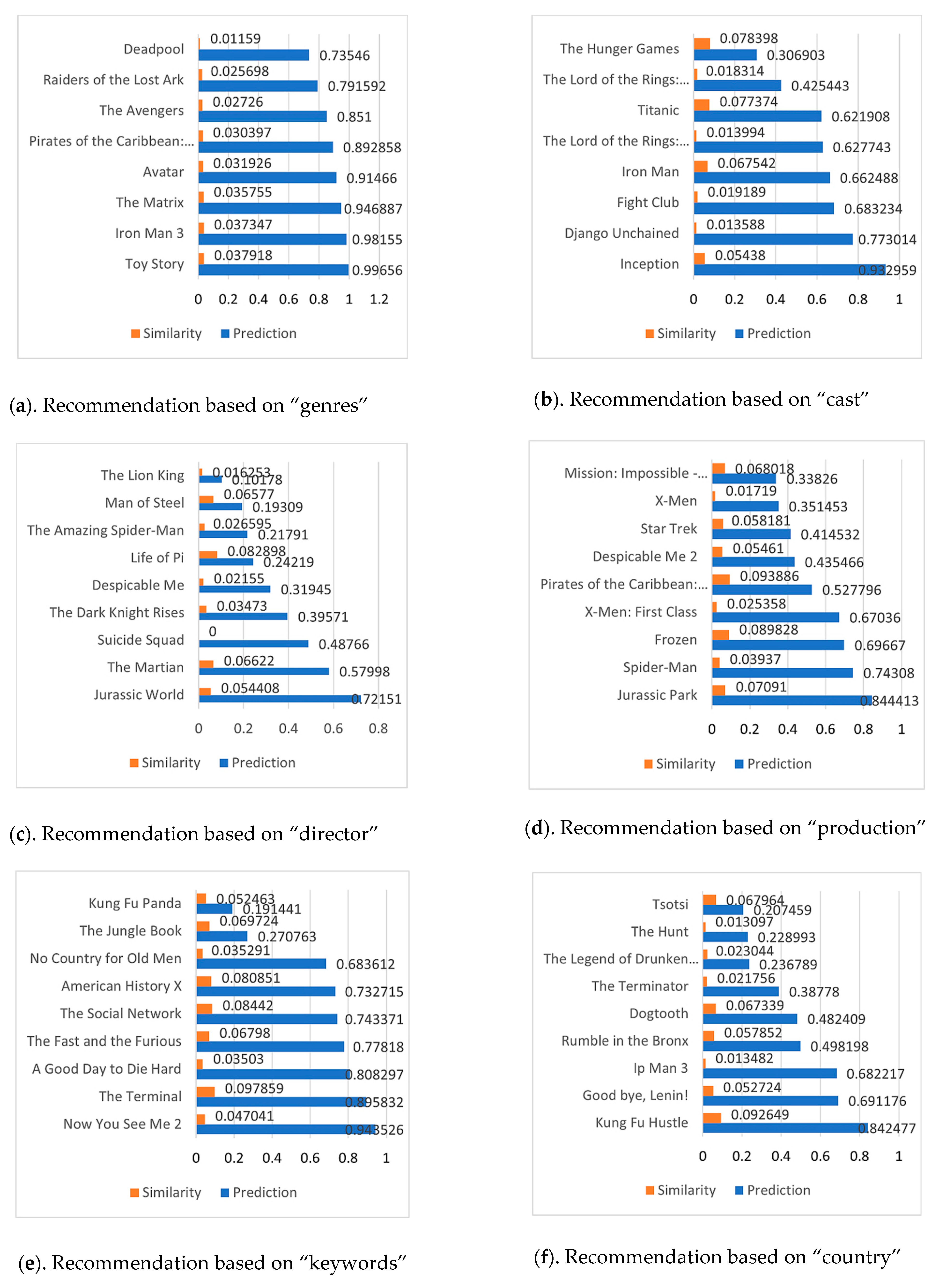

| Original Title | Action | Adventure | Fantasy | Science Fiction | Comedy |
|---|---|---|---|---|---|
| Avatar | 1 | 1 | 1 | 1 | 0 |
| Pirates of the Caribbean: At World’s End | 0 | 1 | 1 | 1 | 0 |
| Iron Man 3 | 1 | 1 | 0 | 1 | 0 |
| Men in Black 3 | 1 | 0 | 0 | 1 | 1 |
| The Avengers | 1 | 1 | 0 | 1 | 0 |
| Spider-Man 3 | 1 | 1 | 1 | 0 | 0 |
| Groups | Distance | Similarities | Prediction | Movies |
|---|---|---|---|---|
| 11 | 0.015331 | 0.977635 | 0.866442 | 319 |
| 2 | 0.056597 | 0.801954 | 0.729645 | 293 |
| 5 | 0.139942 | 0.751964 | 0.626604 | 256 |
| 13 | 0.240842 | 0.728648 | 0.618448 | 249 |
| 15 | 0.268573 | 0.715589 | 0.415094 | 245 |
| 8 | 0.457914 | 0.698504 | 0.353295 | 215 |
| 18 | 0.316397 | 0.570255 | 0.131934 | 210 |
| 1 | 0.569603 | 0.554871 | 0.135821 | 204 |
| 9 | 0.586825 | 0.539715 | 0.139084 | 186 |
| 6 | 0.665498 | 0.533918 | 0.148434 | 165 |
| 14 | 0.691448 | 0.502431 | 0.151520 | 151 |
| 7 | 0.724035 | 0.331711 | 0.177439 | 144 |
| 16 | 0.801747 | 0.325416 | 0.131843 | 142 |
| 12 | 0.809087 | 0.293986 | 0.317141 | 118 |
| 10 | 0.810619 | 0.207995 | 0.283613 | 104 |
| 3 | 0.832163 | 0.125394 | 0.243887 | 77 |
| 4 | 0.932947 | 0.110821 | 0.131934 | 61 |
| 17 | 0.936839 | 0.08863 | 0.039587 | 59 |
| Algorithm | Accuracy | Precision | Recall | AUC |
|---|---|---|---|---|
| Proposed | 0.8831 | 0.8954 | 0.8525 | 0.9218 |
| Bernoulli’s Naive Bayes [70] | 0.875 | 0.884 | 0.8633 | 0.8735 |
| Multinomial NB [70] | 0.885 | 0.9294 | 0.8333 | 0.8787 |
| SVM [70] | 0.8733 | 0.859 | 0.8933 | 0.8753 |
| NB [71] | 0.8183 | 0.84 | 0.79 | 0.82 |
| SVM [71] | 0.8745 | 0.87 | 0.88 | 0.88 |
| Random forest [71] | 0.9601 | 0.93 | 1 | 0.96 |
| CNN [72] | 0.8915 | 0.8259 | 0.8246 | 0.8253 |
| LSTM [72] | 0.955 | 0.9087 | 0.8228 | 0.8636 |
| Method | Input | Output | Type of Algorithm | Handles Missing Data? | Interpretability | Scalability | Requires Labeled Data? |
|---|---|---|---|---|---|---|---|
| Weighted matrix factorization | User-item ratings matrix | Prediction matrix | Collaborative filtering | No | Low | High | No |
| Gaussian distribution rule | User-item ratings matrix | Probability density matrix | Content-based filtering | Yes | Medium | Low | No |
| Cosine triangle similarity | User-item ratings matrix | Similarity matrix | Collaborative filtering | No | Low | High | No |
| EM algorithm | User-item ratings matrix | Probability density matrix | Clustering | No | Low | Medium | No |
| Probability density function | User-item ratings matrix | Probability density matrix | Clustering | No | Low | Medium | No |
| Gaussian mixtures model | User-item ratings matrix | Probability density matrix | Clustering | No | Low | Medium | No |
Disclaimer/Publisher’s Note: The statements, opinions and data contained in all publications are solely those of the individual author(s) and contributor(s) and not of MDPI and/or the editor(s). MDPI and/or the editor(s) disclaim responsibility for any injury to people or property resulting from any ideas, methods, instructions or products referred to in the content. |
© 2023 by the authors. Licensee MDPI, Basel, Switzerland. This article is an open access article distributed under the terms and conditions of the Creative Commons Attribution (CC BY) license (https://creativecommons.org/licenses/by/4.0/).
Share and Cite
Wang, L.; Mistry, S.; Hasan, A.A.; Hassan, A.O.; Islam, Y.; Junior Osei, F.A. Implementation of a Collaborative Recommendation System Based on Multi-Clustering. Mathematics 2023, 11, 1346. https://doi.org/10.3390/math11061346
Wang L, Mistry S, Hasan AA, Hassan AO, Islam Y, Junior Osei FA. Implementation of a Collaborative Recommendation System Based on Multi-Clustering. Mathematics. 2023; 11(6):1346. https://doi.org/10.3390/math11061346
Chicago/Turabian StyleWang, Lili, Sunit Mistry, Abdulkadir Abdulahi Hasan, Abdiaziz Omar Hassan, Yousuf Islam, and Frimpong Atta Junior Osei. 2023. "Implementation of a Collaborative Recommendation System Based on Multi-Clustering" Mathematics 11, no. 6: 1346. https://doi.org/10.3390/math11061346
APA StyleWang, L., Mistry, S., Hasan, A. A., Hassan, A. O., Islam, Y., & Junior Osei, F. A. (2023). Implementation of a Collaborative Recommendation System Based on Multi-Clustering. Mathematics, 11(6), 1346. https://doi.org/10.3390/math11061346










